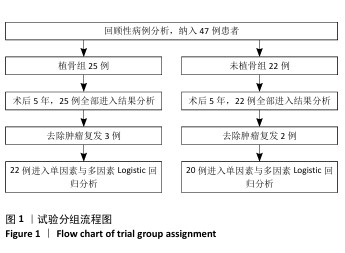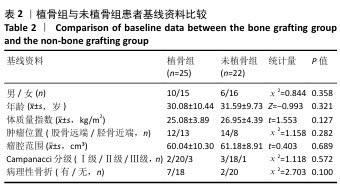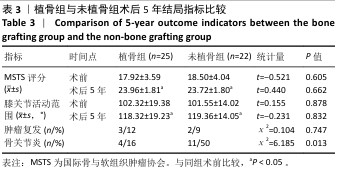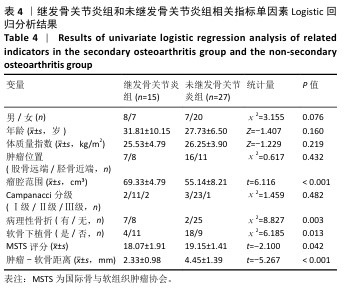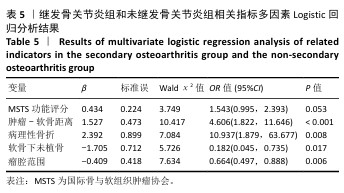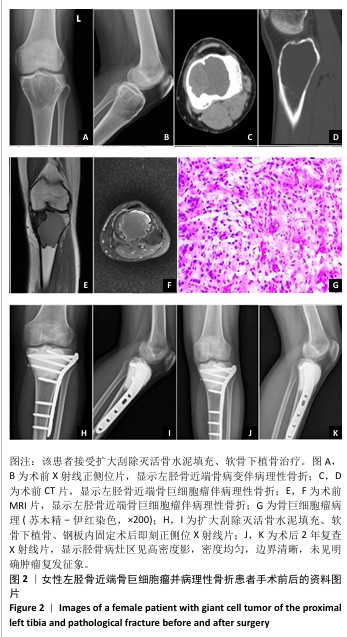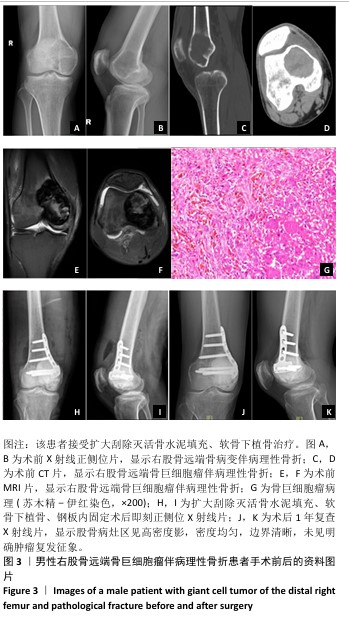[1] YANG YF, WANG JW, GAO XS, et al. Joint Salvage and Biological Repair of Massive-Cavity Bone Defects After Extensive Curettage of Campanacci Grade II or III Giant Cell Tumor Around the Knee With Vascularized Fibular Autograft and Cancellous Allograft. Ann Plast Surg. 2021;87(5):537-541.
[2] RIGOLLINO AV, FERNANDO TS, TANAKA MH, et al. Giant cell tumor locally advanced around the knee: treatment and literature review. Rev Bras Ortop. 2017;52(4):473-478.
[3] JHA Y, CHAUDHARY K. Giant Cell Tumour of Bone:A Comprehensive Review of Pathogenesis,Diagnosis,and Treatment. Cureus. 2023;15(10): e46945.
[4] AOUDE A, NIKOMAROV D, PERERA JR, et al. Giant cell tumour of bone. Bone Joint J. 2023;105-B(5):559-567.
[5] HASAN O, ALI M, MUSTAFA M, et al. Treatment and recurrence of giant cell tumors of bone - A retrospective cohort from a developing country. Ann Med Surg (Lond). 2019;48:29-34.
[6] KOUCHEKI R, GAZENDAM A, PERERA J, et al. Management of giant cell tumors of the distal radius: a systematic review and meta-analysis. Eur J Orthop Surg Traumatol. 2023;33(4):759-772.
[7] BERNARDES M, SANTOS F, FRIAS M, et al. Giant Cell Tumor with Fracture of the Proximal Radius - Reconstructive Surgery with Radius Allograft. J Orthop Case Rep. 2020;10(3):32-35.
[8] ERRANI C, TSUKAMOTO S, LEONE G, et al. Higher local recurrence rates after intralesional surgery for giant cell tumor of the proximal femur compared to other sites. Eur J Orthop Surg Traumatol. 2017;27(6): 813-819.
[9] SAIBABA B, CHOUHAN DK, KUMAR V, et al. Curettage and reconstruction by the sandwich technique for giant cell tumours around the knee. J Orthop Surg (Hong Kong). 2014;22(3):351-355.
[10] KUNDU ZS, GOGNA P, SINGLA R, et al. Joint salvage using sandwich technique for giant cell tumors around knee. J Knee Surg. 2015;28(2): 157-164.
[11] ZHANG S, ZHANG J, WANG X. Comparison of tumor curettage and resection for treatment of giant cell tumor of the bone around the knee joint. Pak J Med Sci. 2016;32(3):662.
[12] HE H, ZENG H, LUO W, et al. Surgical treatment options for giant cell tumors of bone around the knee joint: extended curettage or segmental resection? Front Oncol. 2019;9:946.
[13] 曹武,叶招明,林秾,等.膝关节周围骨巨细胞瘤刮除后填充骨水泥对关节软骨影响的临床研究[J].中国修复重建外科杂志, 2014,28(12):1459-1463.
[14] ENNEKING WF, DUNHAM W, GEBHARDT MC, et al. A system for the functional evaluation of reconstructive procedures after surgical treatment of tumors of the musculoskeletal system. Clin Orthop Relat Res. 1993;(286):241-246.
[15] ABOULAFIA AJ, ROSENBAUM DH, SICARD-ROSENBAUM L, et al. Treatment of large subchondral tumors of the knee with cryosurgery and composite reconstruction. Clin Orthop Relat Res. 1994;(307): 189-199.
[16] BEHERA KC, SINGLA M, YADAV U, et al. A Tertiary Care Centre Experience of Recurrent Giant Cell Tumor Around the Knee Joint. Cureus .2022;14(9):e29788.
[17] ALYAMI AH, NAZER A, BASHAWIEH HH, et al. Outcomes in Bone Giant Cell Tumors Treated With Surgical Resection With and Without Denosumab Injection: A Single-Institution Retrospective Study. Cureus. 2022;14(7):e26869.
[18] CAUBÈRE A, HARROSCH S, FIORAVANTI M, et al. Does curettage–cement packing for treating giant cell tumors at the knee lead to osteoarthritis? Orthop Traumatol Surg Res. 2017;103(7):1075-1079.
[19] COSTELLO JP 2ND, TRAVIS LM, JAHN J, et al. The Role of Bone Grafting vs. Bone Cement in the Treatment of Giant Cell Tumor of Bone: A Systematic Review and Meta-Analysis on the Risk of Recurrence in 1,454 Patients. JBJS Rev. 2024;12(9). doi: 10.2106/JBJS.RVW.24.00080. eCollection 2024 Sep 1.
[20] PARMEGGIANI A, MICELI M, ERRANI C, et al. State of the Art and New Concepts in Giant Cell Tumor of Bone: Imaging Features and Tumor Characteristics. Cancers (Basel). 2021;13(24):6298.
[21] KUMAR A, SINHA S, HAIDER Y, et al. Role of Zoledronic Acid Supplementation in Reducing Post-Surgical Recurrence of Giant Cell Tumor of Bone: A Meta-Analysis of Comparative Studies. Cureus. 2021;13(7):e16742.
[22] JAMSHIDI K, SHARIFI DALOOEI SMA, BAGHERIFARD A, et al. Total Synovectomy and Bone Grafting/Cementation after Curettage of the Bone Lesion in Diffuse Type of Tenosynovial Giant Cell Tumor: A Retrospective Cohort Study. Arch Bone Jt Surg. 2023;11(5):342-347.
[23] EBEID WA, BADR IT, MESREGAH MK, et al. Incidence and progression of osteoarthritis following curettage and cementation of giant cell tumor of bone around the knee: long-term follow-up. J Orthop Traumatol. 2023;24(1):11.
[24] TAKEUCHI A, YAMAMOTO N, OHMORI T, et al. Primary total knee arthroplasty assisted by computed tomography-free navigation for secondary knee osteoarthritis following massive calcium phosphate cement packing for distal femoral giant-cell bone tumor treatment: a case report. BMC Musculoskelet Disord. 2022;23(1):170.
[25] 宋光泽,赵慧霞.膝关节周围骨巨细胞瘤刮除术后填充骨水泥对关节功能影响[J].现代仪器与医疗,2018,24(2):53-55.
[26] WU M, YAO S, XIE Y, et al. A novel subchondral bone-grafting procedure for the treatment of giant-cell tumor around the knee: a retrospective study of 27 cases. Medicine. 2018;97(45):e13154.
[27] SAHITO B, ALI SME, MAJID B, et al. Outcomes of extended curettage with and without bone allograft for grade ii giant cell tumors around the knee. A retrospective comparative study. Rev Bras Ortop (Sao Paulo). 2022;58(1):141-148.
[28] CHEN TH, SU YP, CHEN WM. Giant cell tumors of the knee: subchondral bone integrity affects the outcome. Int Orthop. 2005;29:30-34.
[29] TENG W, LIN P, LI Y, et al. Bone combined cement grafting in giant cell tumor around the knee reduces mechanical failure. Int Orthop. 2019;43:475-482.
[30] 王林,高嵩涛,刘继军,等.膝关节骨巨细胞瘤刮除填充术后继发骨关节炎的危险因素分析及预测模型的建立[J].现代肿瘤医学, 2024,32(12):2255-2261.
[31] XU HR, NIU XH, ZHANG Q, et al. Subchondral bone grafting reduces degenerative change of knee joint in patients of giant cell tumor of bone. Chin Med J (Engl). 2013;126(16):3053-3056.
[32] ARAKI Y, YAMAMOTO N, HAYASHI K, et al. Secondary osteoarthritis after curettage and calcium phosphate cementing for giant-cell tumor of bone around the knee joint: long-term follow-up. JBJS Open Access. 2020;5(3):e19. |
